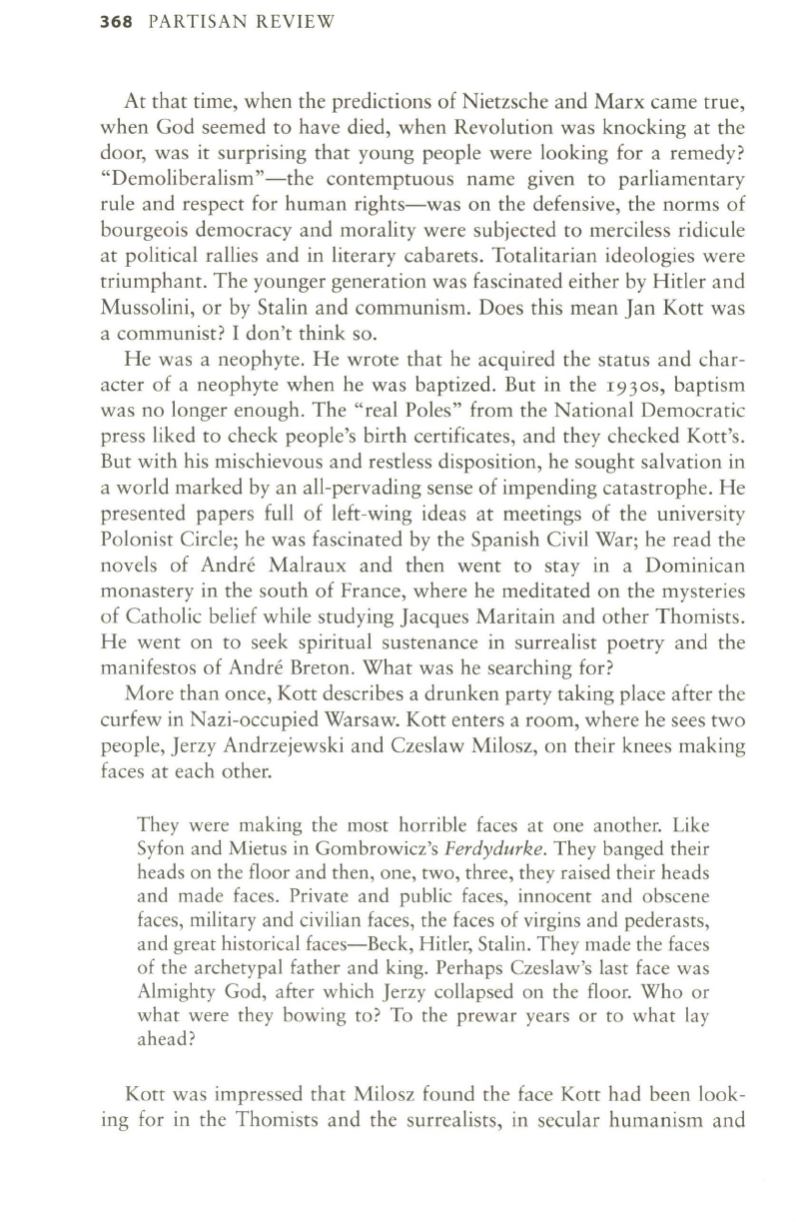
368
PARTISAN REVIEW
At that time, when the predictions of Nietzsche and Marx came true,
when God seemed to have died, when Revolution was knocking at the
door, was it surprising that young people were looking for a remedy?
"Demoliberalism"-the contemptuous name given to parliamentary
rule and respect for human rights-was on the defensive, the norms of
bourgeois democracy and morality were subjected
to
merciless ridicule
at political rallies and in literary cabarets. Totalitarian ideologies were
triumphant. The younger generation was fascinated either by Hitler and
Mussolini, or by Stalin and communism. Does this mean Jan Kott was
a communist? I don't think so.
He was a neophyte. He wrote that he acquired the status and char–
acter of a neophyte when he was baptized. But in the 1930S, baptism
was no longer enough. The "real Poles" from the National Democratic
press liked to check people's birth certificates, and they checked Kott's.
But with his mischievous and restless disposition, he sought salvation in
a world marked by an all-pervading sense of impending catastrophe. He
presented papers full of left-wing ideas at meetings of the university
Polonist Circle; he was fascinated by the Spanish Civil War; he read the
novels of Andre Malraux and then went
to
stay in a Dominican
monastery in the south of France, where he meditated on the mysteries
of Catholic belief while studying Jacques Maritain and other Thomists.
He went on to seek spiritual sustenance in surrealist poetry and the
manifestos of Andre Breton. What was he searching for?
More than once, Kott describes a drunken party taking place after the
curfew in Nazi-occupied Warsaw. Kott enters a room, where he sees two
people, Jerzy Andrzejewski and Czeslaw Milosz, on their knees making
faces at each other.
They were making the most horrible faces at one another. Like
Syfon and Mietus in Gombrowicz's
Ferdydurke.
They banged their
heads on the floor and then, one, two, three, they raised their heads
and made faces. Private and public faces, innocent and obscene
faces, military and civilian faces, the faces of virgins and pederasts,
and great historical faces-Beck, Hitler, Stalin. They made the faces
of the archetypal father and king. Perhaps Czeslaw's last face was
Almighty God, after which Jerzy collapsed on the floor. Who or
what were they bowing to? To the prewar years or to what lay
ahead?
Kott was impressed that Milosz found the face Kott had been look–
ing for in the Thomists and the surrealists, in secular humanism and


